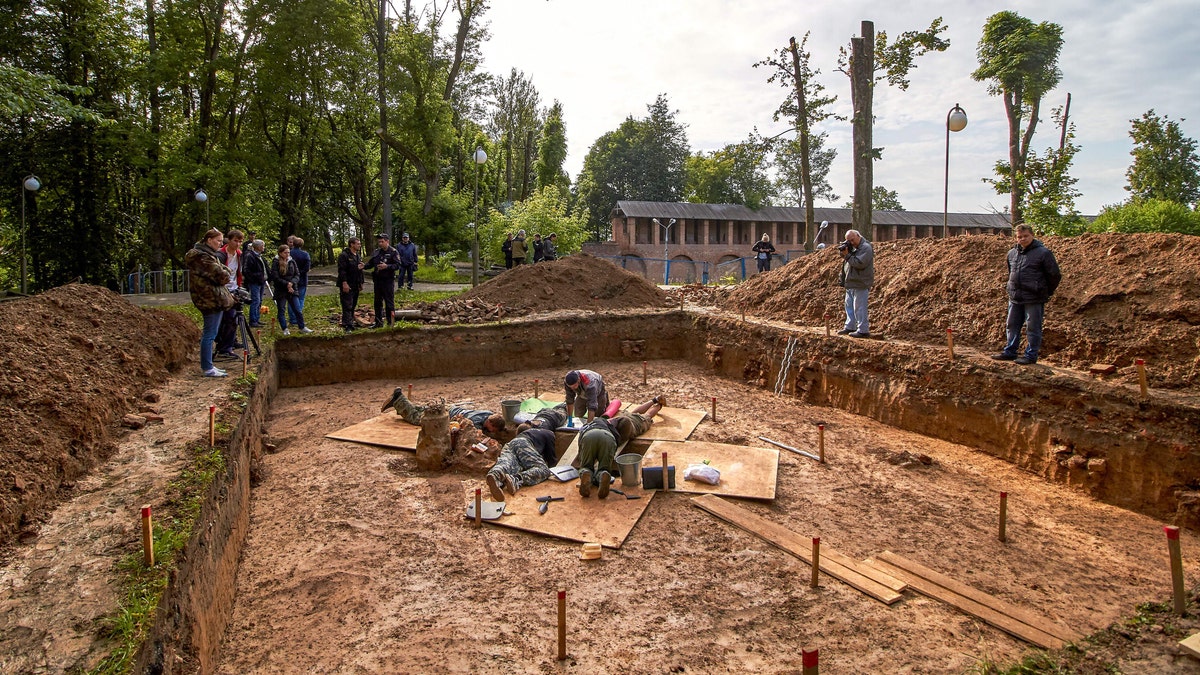One-legged skeleton discovered beneath Russian dance floor may be Napoleon's favorite general
Charles-Etienne Gudin de la Sablonniere, who was a classmate of Napoleon’s from military school, took part in Napoleon’s ill-fated invasion of Russia. Beneath an outdoor dance floor in Smolensk, Russia, researchers believe they have found Gudin's final remains after 207 years.
Archaeologists in Russia recently discovered a one-legged skeleton buried beneath a dance floor that may solve a 207-year-old mystery about the final resting place of Napoleon’s favorite general.
The skeleton is believed to belong to French general Charles-Etienne Gudin de la Sablonniere, who was struck by a cannonball during Napoleon’s ill-fated invasion of Russia in 1812.
Gudin was critically injured during the Battle of Valutino near Smolensk on Aug. 19, 1812, according to AFP and France 24. The leg of the 44-year-old general was amputated but his wound became gangrenous and he died three days later.
NAPOLEONIC DISCOVERY: PIECES OF SOLDIERS' UNIFORMS FROM DOOMED INVASION OF RUSSIA UNCOVERED
The remains were discovered last month, Reuters reports, noting that they were found beneath an outdoor dance floor in a Smolensk park. At a press conference Thursday, researchers said that the remains would be repatriated and DNA tests performed on them at a French laboratory.

A picture taken on July 7, 2019 shows the supposed remains of French General Charles Etienne Gudin de la Sablonniere in Smolensk, Russia. (DENIS MAXIMOV/AFP/Getty Images)
Historian Pierre Malinowski has led French and Russian archaeologists in the search to find the general’s remains, an effort that is reportedly supported by the Kremlin. Malinowski is confident that the skeleton belongs to General Gudin.
In a Facebook post on Thursday, Malinowski described the discovery as an important day for France and Russia.
GRISLY AMPUTATED LIMBS, FRENCH HOWITZER SHELL, DISCOVERED AT BATTLE OF WATERLOO SITE
A classmate of Napoleon’s from military school, Gudin is described as a favorite general of the French Emperor.

Archaeologists work on July 7, 2019 at a site of the supposed burial place of French General Charles Etienne Gudin de la Sablonniere. (DENIS MAXIMOV/AFP/Getty Images)
After his death, French troops cut Gudin’s heart from his body and brought it back to France, placing it in a chapel at Paris’ famous Pere Lachaise cemetery, according to Napoleon-monuments.eu. The general’s name is also inscribed on the Arc de Triomphe.
Napoleon’s gigantic “Grande Armee” began its invasion of Russia on June 24, 1812. Estimates of the army’s size range from 450,000 to 650,000 troops, according to History.com. The campaign quickly degenerated into a military disaster as retreating Russian forces employed a “scorched earth” policy that denied food and shelter to the invading army.
FIRST COMPLETE BATTLE OF WATERLOO SKELETON IDENTIFIED AS GERMAN SOLDIER
When Napoleon reached Moscow in September, the city, like others in his path, had already been set ablaze and the French army was forced to retreat as winter neared. Ravaged by battle, starvation, disease and the devastating Russian winter, there were only around 100,000 soldiers in Napoleon’s army when it left Russia in December 1812.

Death of General Gudin at the Battle of Valutino. Found in the collection of the Russian State Library, Moscow. (Photo by Fine Art Images/Heritage Images/Getty Images)
Buttons from uniforms worn by soldiers in Napoleon’s army were recently uncovered in Lithuania.
The discoveries were made during an excavation at the site of the Great Synagogue of Vilna (Vilnius), which was razed during the Nazi occupation of Lithuania in World War II.
NAPOLEON DYNAMITE: HOW AN INDONESIAN VOLCANO INFLUENCED THE BATTLE OF WATERLOO
One of the key figures in European history, Napoleon remains a source of fascination. Last year, an extremely rare ‘bicorne,’ or two-pointed hat, that was worn by the French leader at the Battle of Waterloo was sold at auction in France for $325,000.
Additionally, archaeologists recently uncovered amputated limbs from the site of a field hospital used in Waterloo.
CLICK HERE TO GET THE FOX NEWS APP
In a separate project, the first complete Battle of Waterloo skeleton was identified in 2015 as a German soldier.
Follow James Rogers on Twitter @jamesjrogers





















